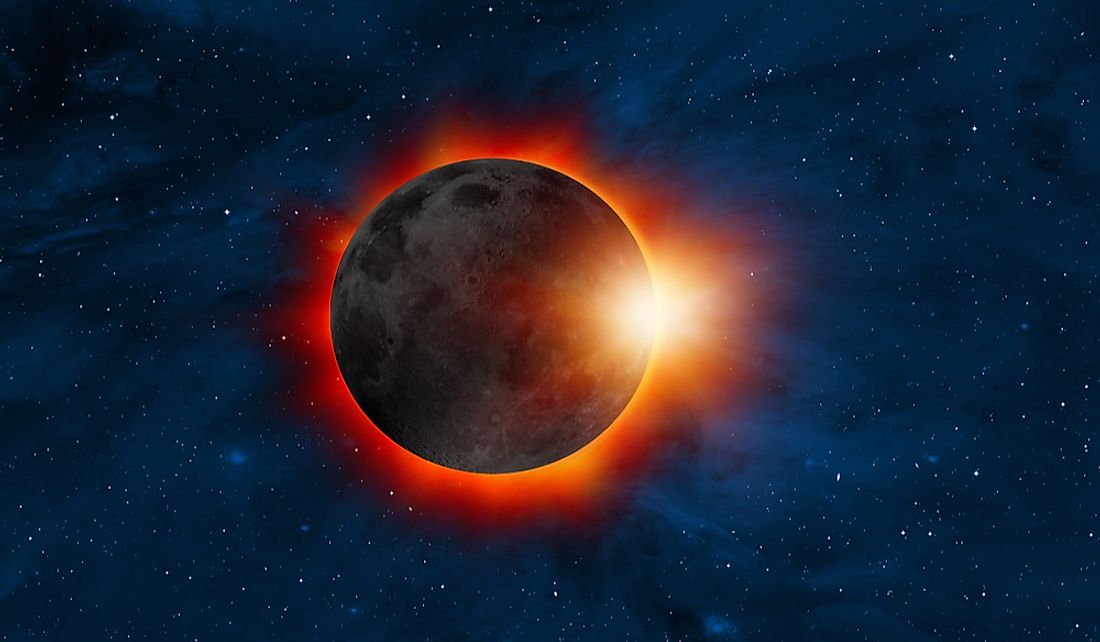What Is Occultation In Astronomy?

In astronomy, occultation refers to an event in which an object is blocked by another object passing between it and the observer. Occultations occur when a planet or the moon passes in front of a star, or when one planet passes in front of another.
Occultations by the Moon
Occultation by the Moon describes occurrences when the Moon passes in front of a star as it orbits around Earth. Since stars have an angular diameter, while the Moon has an atmosphere which is very thin, the Moon will occult the star or will disappear and then reappear again in less than 0.1 seconds on the limb of the Moon. This occultation can be clearly observed due to a lack of glare. Any star with an ecliptic latitude of less than 6.5 degrees can be occulted by the Moon since it has an inclined orbit to the ecliptic. The three first magnitude stars, Spica, Antares, and Regulus, are close to the ecliptic and can be occulted by planets and the Moon. Planets pass Aldebaran, a red giant star, to the north, and therefore the occultation of Aldebaran is only possible by the Moon. The Pleiades, which is an open cluster of stars, can also be occulted by the Moon. Neither lunar or planetary occultation of Pollux, an orange giant star, is possible at this time, but the occultation of Pollux will likely be possible in the far future.
A grazing lunar occultation occurs when a star intermittently disappears and reappears, as the irregular edge of the star moves past the Moon. Lunar occultations are timed for scientific purposes, such as increasing knowledge of lunar topography. Planets are also occasionally occulted by the Moon, and this can be observed by humans on Earth. The same can be observed with the Sun, which is viewed as a solar eclipse.
Occultations by Planets
Planets can also occult stars. For example, Venus occulted Regulus in 1959, while Uranus blocked a star in 1977, leading to the discovery of the planet's rings. Saturn occulted the 5th magnitude star 28 Sagittarii in 1989, and Pluto occulted stars in 1988, 2002 and 2006.
Mutual Planetary Occultations
Mutual planetary occultations occur when one planet passes in front of another. The distant planet appears smaller than the nearer planet. However, this phenomenon rarely occurs.
Occultations by Minor Planets
Minor planets include dwarf planets, distant objects, or asteroids. Occultation by minor planets occurs when a minor planet occults a star, temporarily obscuring its light. Occultations by minor planets are studied in order to measure the positions and sizes of minor planets. Occultations can also occur between a minor planet and its satellite. For instance, there were eight asteroid occultations on March 12, 2009, as well as the occultation of the dwarf planet Eris on November 6, 2010.
Double Occultations
Double occultations occur when the Moon or any other celestial body occults multiple celestial bodies simultaneously. The Moon has a large angular diameter and therefore can occult a number of stars at the same time. However, the Moon rarely occults two bright objects at the same time, such as two planets or a planet and a bright star.
Artificial Occultations
Artificial occultation can occur when an artificial satellite comes between a space telescope and a star. In such cases, the occultation occurs intentionally, by maneuvering the artificial satellite into a specific position. For example, the Big Occulting Steerable Satellite (BOSS), was a proposed satellite designed to be used together with a telescope in order to detect planets.











